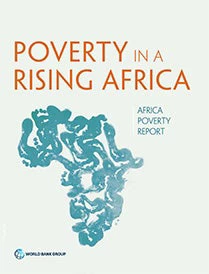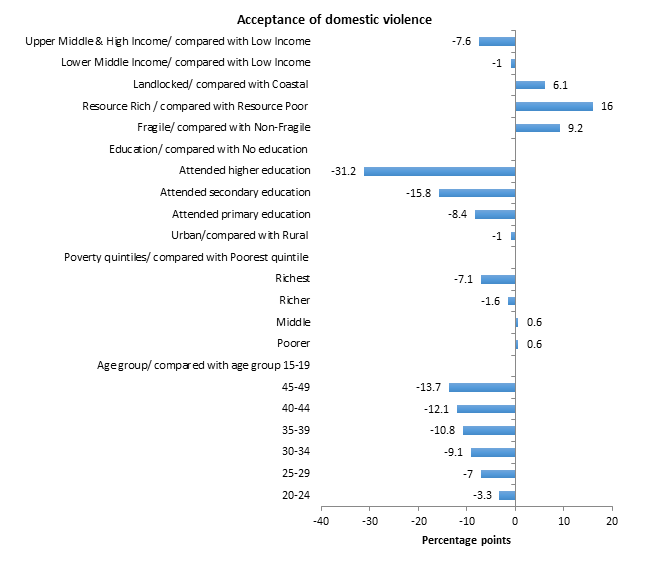
To be sure, the numbers reflect attitudes, not incidence. About one third of African women report to have experienced domestic violence (physical or sexual). But the attitudes are arguably even more pernicious. They shape behavior, reflect social norms toward conflict resolution, also outside the home, and could bear importantly on development and poverty reduction. They are also correlated with the incidence of violence. In assessing people’s poverty status and well-being, a much more systematic discussion of the acceptance and incidence of domestic violence is called for.
So, what has been happening to women’s attitudes and incidence towards domestic violence following Africa’s hopeful economic turn-around? Two decades of systematic data collection through the Demographic and Health Surveys make it possible to examine this. The latest Poverty in a Rising Africa report summarizes the findings.
In some ways, the news is good. The prevalence of both acceptance and incidence of domestic violence declined by about 10 percentage points between the first (2000-6) and second half (2007-2013) of the 2000s. But that can only be the beginning. At 51%, acceptance of domestic violence is still exceptionally high, and more than twice the average in the rest of the developing world. With 20% of women in North America reporting to have been affected by domestic violence, domestic violence also remains an issue worldwide.
Yet acceptance is not uniform across countries. It appears deeply ingrained in some societies (77% acceptance rates in Mali and Uganda); in others, only a minority consents (13% in Malawi, 21% in Mozambique). The link with a country’s overall level of development (or household income within countries) is weak; acceptance rates are only 7.6 percentage points lower in upper middle and high income countries, controlling for other country traits. (See the Figure below, which shows that acceptance of domestic violence is greater among younger women, uneducated women, and women in resource-rich and fragile states.)
On the other hand, acceptance is 16 percentage points higher in resource rich countries. This once again underscores the stark human development penalty of being born in a resource rich country: life expectancy is 4.5 years lower; illiteracy rates are 3.1% higher, and female adults and children are 3.7 and 2.1% more likely to be undernourished respectively (controlling for other country and household traits).
Tolerance of domestic violence is also 9.2 percentage points higher among women in fragile states. Social norms toward domestic violence and political violence can and should not be seen in isolation. The cross country correlation coefficient with the incidence of casualties from political violence is 0.4.

What about the future? Unsurprisingly, the main distinguishing factor in acceptance of domestic violence is education, much more so than income, or even age. Highly-educated women are 31% less likely to be tolerant of domestic violence than women with no education, and women with secondary education are 16% less likely to be tolerant.
Education does, however, not automatically translate in a lower incidence of domestic violence. In fact, women with primary and secondary education are more likely to have experienced domestic violence than uneducated women, among whom incidence rates are (ceteris paribus) similar to rates among women with higher education, a puzzle which deserves further inquiry.
Income also reduces tolerance of domestic violence, though disturbingly, tolerance is greater among younger women! It declines with age. Might this be because its incidence rises as women get older, as the data show that domestic violence is more common in the 20-35 age group than among the 15-19 age group?
The issue of gender-based violence has been creeping up the policy agenda over the past couple of years, not least because of the much more systematic data now available. This attests in no small way to one of the undercurrents in the Poverty in a Rising Africa report, which is that what isn’t measured, does not get attention. The hope now is that these data will also be used more systematically to shed light on the evolution of the attitudes and incidence of domestic violence and that such discussions will indeed become part and parcel of any national, regional or global assessment of poverty.
The understanding of poverty cannot be relegated to the monetary realm only. Furthermore, social norms that condone violence, also perpetuate it. With younger women still substantially more tolerant of domestic violence, a generational shift in mindset is, unfortunately, yet to come. Before the husband’s beating stick no longer feels like butter, as a saying in Amharic would hold, a long way lies ahead.
This blog is part of a series reflecting on the findings of the 2016 World Bank Report “Poverty in a Rising Africa." Next in the series: poverty differences within African households on Jan 25, 2016. Previous blogs in the series include:
- Africa is rising! But are people better off?
- Who will fund poverty surveys in Volkswagen countries?
- The European refugee crisis: What we can learn from refugees in Sub-Saharan Africa
- Poverty is falling faster for female-headed households in Africa
- The shock of widowhood: Marital status and poverty within Africa


Join the Conversation